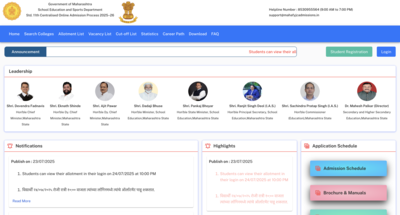AI in schools just got federal backing, but will US Education Department survive long enough for the change?

The US Department of Education has officially encouraged schools to adopt artificial intelligence (AI) tools in classrooms, releasing detailed guidance this week on how existing federal grants can support AI integration. The move signals a significant policy shift toward digitizing education through personalized learning tools, high-impact tutoring systems, and AI-enabled career counseling platforms.Alongside the guidance, the department also issued a proposed rule in the Federal Register, outlining clear priorities for schools and districts seeking discretionary grant funding for AI projects. These include embedding AI literacy into classroom lessons, supporting dual enrollment opportunities for high school students in AI-related credentials, and using AI to streamline administrative workloads or enhance teacher training.But even as this federal push for AI unfolds, a deeper institutional concern remains unresolved: the Education Department itself may not be around to oversee or sustain this transformation.
Technology push, oversight vacuum
Earlier this year, the Trump administration dismantled the Office of Educational Technology (OET), the division historically tasked with leading digital learning, edtech strategy, and AI governance in schools. This closure occurred just months before the release of the new AI guidance, leaving a gap in leadership and long-term strategy at a time of rapid technological change.At the same time, the administration continues to advance its plan to fully dismantle the USDepartment of Education—a move that raises urgent questions about who will guide the safe, equitable, and effective use of AI in schools if the department ceases to exist.This contradiction—pushing for nationwide AI adoption while scaling back the very infrastructure needed to manage it—has sparked concern across education circles, particularly among district leaders tasked with implementing these changes without federal oversight or support.
Cybersecurity, funding, and capacity challenges
Beyond AI instruction, districts are also facing rising cybersecurity risks. In 2024, schools applied for over $3.7 billion in funding from the Federal Communications Commission’s limited $200 million cybersecurity pilot program, indicating the scale of vulnerability and underfunding in digital safety systems.The closure of federal programs that supported K–12 cybersecurity, along with the elimination of edtech guidance offices, has created significant uncertainty. Many districts previously relied on federal threat intelligence sharing and response services that are no longer available. As AI tools become more embedded in teaching, learning, and administration, the risk of cyberattacks grows—but the support to mitigate those threats has shrunk.
What the new AI guidance includes
Despite the surrounding policy instability, the Education Department’s guidance does offer actionable direction for schools. It encourages the use of AI for:
- Enhancing curriculum tools and tutoring
- Training teachers in AI and computer science fundamentals
- Supporting students with disabilities through adaptive technologies
- Automating time-consuming administrative tasks
- Offering students access to industry-recognized credentials in AI
The department also laid out five core principles for responsible AI adoption in schools: that initiatives should be educator-led, ethical, accessible, transparent, and compliant with existing data privacy laws.Public comments on the proposed AI priorities are open through August 20, offering an opportunity for educators, school officials, and other stakeholders to influence how federal funds are directed.
An unclear future for AI governance in education
The Education Department’s embrace of AI marks a bold shift in how USclassrooms may operate in the coming years. However, the absence of stable federal leadership—and the real possibility that the agency may be dismantled entirely—casts uncertainty over who will ensure responsible implementation, student safety, and equitable access to these new technologies.As schools move ahead with AI adoption, they may find themselves navigating this shift without the institutional support historically provided by the federal government. Whether that gap will be filled by states, private entities, or new structures remains to be seen.TOI Education is on WhatsApp now. Follow us here.





